Past historians can thus inform us through their errors as well as by their statements.
An interesting example of this lies in the accounts describing the Battle of Pliska, in which a Byzantine army was annihilated and Emperor Nicephorus I slain and turned into a drinking gourd.
2.) The Achaemenids, who even maintained control over the Ionian Greek cities after their twin defeats in the invasions of mainland Greece.
"There was no end to the ways in which nice things are nicer than nasty ones."
"Attractive people doing attractive things in attractive places" was Slim Aarons' motto. The eighteenth century understood this!
Rococo is an underappreciated style of painting, dismissed for being light and frivolous—its chief virtue!
How did Medici control Florence? They were notorious for being the true rulers behind a republican facade, but how did they actually exercise power? John Padgett and Christopher Ansell’s 1993 paper was a network analysis of their power base. Thread.
https://t.co/QIF28oTKIw
A teaser thread for 'Saladin the Strategist', which will be out soon. All my threads on it will be posted in the replies, along with the introduction here:
https://t.co/yhKcU9j9QC
I posted the introduction to 'Saladin the Strategist: How the Crusaders Lost the Holy Land', which will be released soon. Also check out the new cover, artwork by the wonderful @yiihya!
https://t.co/yhKcU9j9QC
The run-up to the Battle of Hattin was like a Crusader Iliad, with tragic parts turned to farce.
An arrogant and vindictive king deprives his best warrior of his rightful property, causing a stand-off until tragedy prompts the latter to reenter the war. Thread.
So true. When they say war represents man's most primitive instincts, this is what they're talking about. https://t.co/7Sx1z6tuRL






















